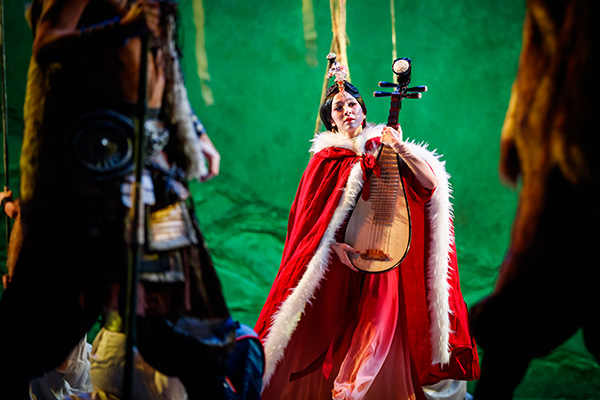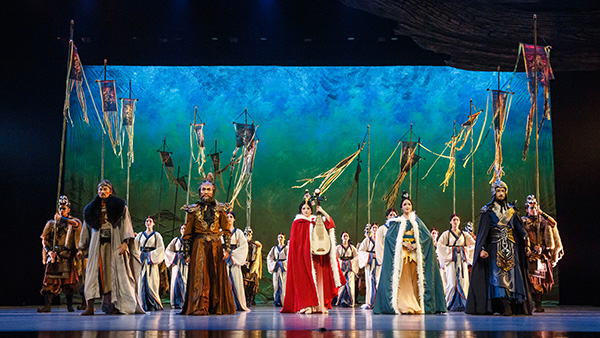



From July 9-11, the dance drama Princess Zhaojun will return to the capital.[Photo provided to China Daily]
The story of Wang Zhaojun, a beautiful princess from the Han Dynasty (206 BC-AD 220), is well-known in the country.
As a symbol of bridging cultures, the princess married the chief of the Xiongnu people, a powerful nomadic tribal group in northern China in conflict with the Han Dynasty at that time. Her marriage, ordered by the Han emperor, brought peace to her country.
Wang's story has been adapted into various art forms. In 2016, the China National Opera& Dance Drama Theater turned Wang's story into a dance drama, titled Princess Zhaojun, which featured the company's star dancer-choreographer Tang Shiyi in the lead role.
Since then, the dance drama has been staged nationwide and internationally, and made its New York debut in 2019. From July 9-11, the dance drama will return to the capital.
"I can still recall vividly when we went to North China's Inner Mongolia autonomous region to collect material for the dance drama. There are stories, paintings, sculptures and cultural relics showing the story of Wang Zhaojun. She is a woman who made a great sacrifice for her country and she also had romance with the man she married yet never met. All those details helped us to portray the role," says Tang.
Born in Yongzhou, Hunan province, Tang, 30, started learning traditional Chinese dance at the age of 6 before receiving a scholarship to study at the affiliated middle school of the Beijing Dance Academy. She graduated from the academy in 2010 and now is the principal dancer of the China National Opera & Dance Drama Theater. She has won many top national awards, including two at the Tao Li Cup, the top honor for young Chinese professional dancers. In 2011, she made her choreographic debut with a dance drama, The Flowing Dance From Tang Poetry, which combined three classic Chinese poems from the Tang Dynasty (618-907)-Spring, River, Flower, Moon, Night by poet Zhang Ruoxu; Song of Everlasting Sorrow by poet Bai Juyi; and Sword Dance by poet Du Fu.
"I have spent most of my life dancing and I believe that traditional Chinese dance, which contains so much history, culture and Chinese philosophy, is very captivating and inspiring. It's very expressive and tells a lot beyond words," says Tang.
One of the most touching moments in the dance drama, as Tang says, is the ending, when Wang looks back on her life.
"Most of the people who accompanied Wang Zhaojun to travel to the Xiongnu tribe had died. She missed them and her home. She held a handful of earth she took from her home and she felt less alone," says Tang. "Though I couldn't talk to her or go back to her time, I share her feelings as a woman. I am deeply touched whenever I dance that part of the performance."
"We all have the experience of traveling far away from home, to study or to pursue our career dream. The story of Wang Zhaojun is still related to our lives today," says the dance drama's choreographer and director Kong Dexin.
Wang Zhaojun is one of the three dance dramas by the China National Opera & Dance Drama Theater, which will tour more than 20 Chinese cities for over a year to celebrate the 100th birthday of the founding of the Communist Party of China.
Besides live performances, artists from China National Opera & Dance Drama Theater will go to art schools and local communities to give workshops and dance classes for children and seniors.
The other two dance dramas are Li Bai, following the life of the legendary Tang Dynasty (618-907) poet Li Bai, and Confucius, which follows the great Chinese sage traveling to 14 states with his students to spread his ideas.
Confucius, also directed by Kong, said to be the 77th-generation direct descendant of Confucius, premiered in 2013 and has been staged over 300 times worldwide. Kong says that what Confucius values is derived from humanity and great love.
Premiered in 2017, Li Bai features director Han Baoquan and dancer Hu Yang performing the leading role. It depicts the poet's passion, talent and persistence.
According to Tang Ying, vice-president of the China National Opera &Dance Drama Theater, the three dance dramas have been streamed on social media platforms both at home and abroad beside live performances, generating a new wave of discussion on the beauty of Chinese culture among art lovers from all over the world.
"From the way of telling stories, choreography to the costumes, stage designs and music, we want to showcase the typical artistic aesthetic from ancient China, through which audiences can better understand Chinese culture," says Tang.

